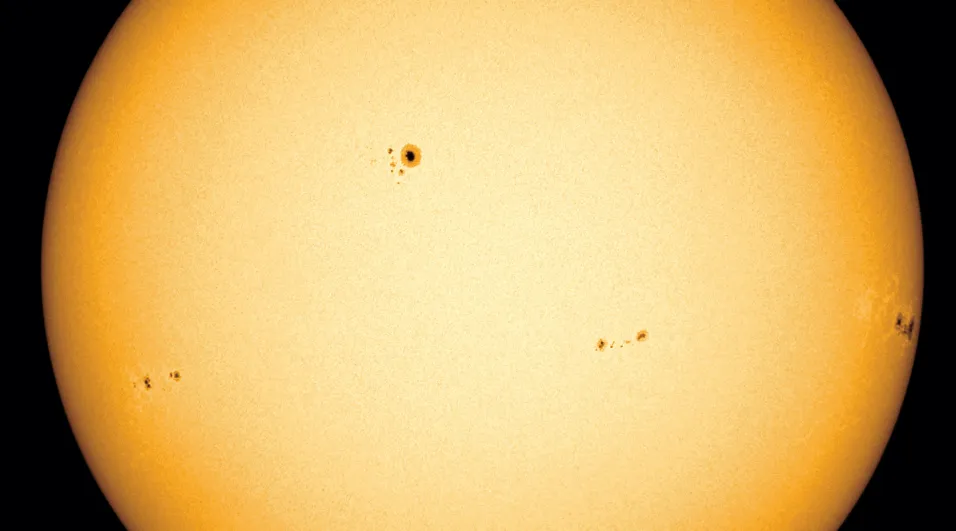Solar Cycle 25: What to Expect from Sunspots in the Coming Years?

The Sun, our closest star, is entering a new phase of activity known as Solar Cycle 25, and the scientific community is buzzing with anticipation.
Anúncios
This cycle, which officially began in December 2019, promises to bring a surge in solar phenomena, including sunspots, solar flares, and coronal mass ejections.
But what exactly does this mean for us on Earth?
How will this cycle differ from its predecessors, and what can we expect in the coming years?
Let’s dive into the fascinating world of solar activity and explore the implications of Solar Cycle 25.
As we move further into this cycle, researchers are keenly observing the Sun’s behavior, hoping to refine their models and predictions.
Understanding the dynamics of solar cycles not only helps in forecasting space weather but also enhances our knowledge of astrophysical processes.
Understanding Solar Cycles: A Brief Overview
Solar cycles are periodic changes in the Sun’s activity, driven by its magnetic field.
These cycles last approximately 11 years and are marked by fluctuations in the number of sunspots—dark, cooler areas on the Sun’s surface caused by intense magnetic activity.
The more sunspots, the more active the Sun.
The previous cycle, Solar Cycle 24, was notably subdued, with fewer sunspots and weaker solar storms than average.
This has led scientists to speculate about the intensity of Solar Cycle 25.
Will it follow the same quiet pattern, or will it roar back with a vengeance?
The historical context of solar cycles can provide insights into potential patterns we might observe.
By studying past cycles, scientists can better understand the Sun’s behavior and its effects on Earth.
Predictions for Solar Cycle 25: A Mixed Bag
According to the National Oceanic and Atmospheric Administration (NOAA) and NASA, Solar Cycle 25 is expected to be similar in strength to its predecessor, with a peak sunspot number of around 115.
This prediction is based on advanced modeling and observations of the Sun’s polar magnetic fields, which are key indicators of future activity.
However, not all experts agree.
Some researchers argue that the Sun may be entering a prolonged period of low activity, akin to the Maunder Minimum of the 17th century, when sunspots virtually disappeared for decades.
This divergence in predictions highlights the complexity of solar dynamics and the challenges of forecasting space weather.
As we gather more data throughout this cycle, adjustments to these predictions may be necessary, reflecting the Sun’s unpredictable nature.
Continued observation and research will be crucial in refining our understanding of solar cycles and their impact on Earth.
+ Sunspots and Their Impact on Earth’s Climate
The Impact of Sunspots on Earth
Sunspots are more than just fascinating solar features; they have real-world consequences.
Increased sunspot activity often leads to more solar flares and coronal mass ejections (CMEs), which can disrupt satellite communications, GPS systems, and even power grids on Earth.
For instance, during the peak of Solar Cycle 23 in 2003, a massive solar storm caused widespread blackouts in Sweden and damaged several satellites.
While Solar Cycle 25 is predicted to be milder, the potential for disruptive space weather events remains a concern.
Understanding the specific mechanisms behind sunspots and their effects can help mitigate these risks.
By developing better forecasting models, we can prepare for potential disruptions and protect our technological infrastructure.

Table 1: Comparison of Recent Solar Cycles
| Solar Cycle | Start Year | Peak Sunspot Number | Notable Events |
|---|---|---|---|
| Cycle 23 | 1996 | 120 | Halloween Solar Storms (2003) |
| Cycle 24 | 2008 | 116 | Weakest cycle in a century |
| Cycle 25 | 2019 | 115 (predicted) | TBD |
The Role of Technology in Monitoring Solar Activity
Advancements in technology have revolutionized our ability to monitor and predict solar activity.
Satellites like NASA’s Solar Dynamics Observatory (SDO) and the European Space Agency’s Solar Orbiter provide unprecedented views of the Sun, allowing scientists to track sunspots, flares, and CMEs in real time.
These tools are crucial for preparing for the effects of Solar Cycle 25.
By understanding the Sun’s behavior, we can better protect our infrastructure and mitigate the risks associated with space weather.
Furthermore, ongoing developments in solar observation technology promise even more detailed insights into solar activity.
As new satellites and instruments come online, our understanding of solar dynamics will continue to improve, leading to better predictions and preparedness.
++ Solar Flares: How These Explosive Events Impact Earth
The Human Element: How Solar Activity Affects Us
Beyond the technical implications, solar cycles also have a cultural and psychological impact.
Auroras, for example, are a direct result of solar activity.
During periods of high sunspot activity, these dazzling light displays become more frequent and visible at lower latitudes.
For many, witnessing an aurora is a once-in-a-lifetime experience.
With Solar Cycle 25 ramping up, skywatchers in regions like the northern United States and Europe may have more opportunities to see these natural wonders.
The excitement surrounding auroras often brings communities together, fostering a sense of wonder and connection to nature.
As awareness of solar cycles grows, educational programs can help people understand the science behind these spectacular events.

Table 2: Historical Auroral Events Linked to Solar Cycles
| Solar Cycle | Year | Auroral Event Description |
|---|---|---|
| Cycle 19 | 1958 | Most intense auroras on record |
| Cycle 22 | 1989 | Quebec Blackout caused by auroral activity |
| Cycle 25 | 2023+ | Increased auroral visibility predicted |
The Bigger Picture: Climate and Solar Cycles
One of the most debated topics in solar science is the relationship between solar cycles and Earth’s climate.
While the Sun’s energy output varies slightly during each cycle, these changes are too small to account for global warming.
However, some researchers suggest that prolonged periods of low solar activity, like the Maunder Minimum, may have contributed to cooler temperatures during the Little Ice Age.
As Solar Cycle 25 unfolds, scientists will continue to study its potential climate impacts, though current evidence suggests that human activities remain the primary driver of modern climate change.
Understanding this relationship is crucial for developing comprehensive climate models and predictions.
Ongoing research will help clarify the extent to which solar activity influences our climate, contributing to informed discussions on climate change mitigation.
Preparing for the Future: Space Weather Forecasting
The study of solar cycles isn’t just an academic pursuit; it’s a matter of practical importance.
Accurate space weather forecasts can help governments and industries prepare for potential disruptions.
For example, airlines may reroute flights to avoid radiation exposure during solar storms, and power grid operators can take steps to prevent blackouts.
With Solar Cycle 25 underway, investments in space weather monitoring and forecasting are more critical than ever.
By staying ahead of the Sun’s activity, we can minimize its impact on our increasingly technology-dependent world.
Collaboration between scientists, governments, and industries will be essential in developing effective strategies for managing space weather risks.
For more information on space weather and its implications, visit NASA’s Space Weather page.
Conclusion: A New Chapter in Solar Science
As Solar Cycle 25 progresses, it offers a unique opportunity to deepen our understanding of the Sun and its influence on our planet.
Whether it brings a surge in sunspots or continues the trend of subdued activity, this cycle will undoubtedly provide valuable insights for scientists and skywatchers alike.
By staying informed and prepared, we can navigate the challenges and marvel at the wonders of our dynamic star.
After all, the Sun isn’t just the center of our solar system—it’s a constant reminder of the intricate connections between the cosmos and life on Earth.
